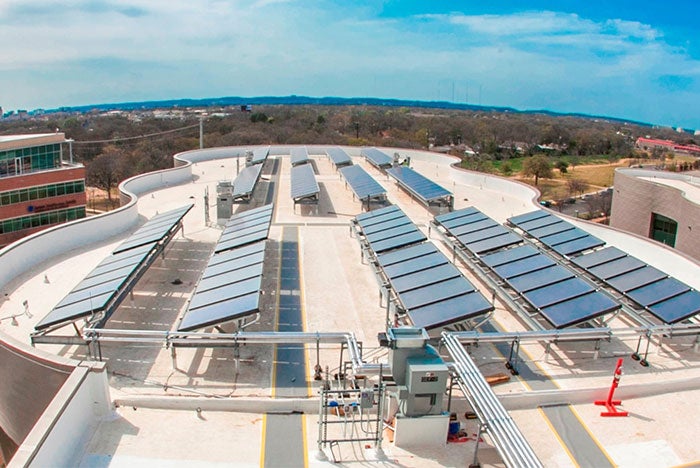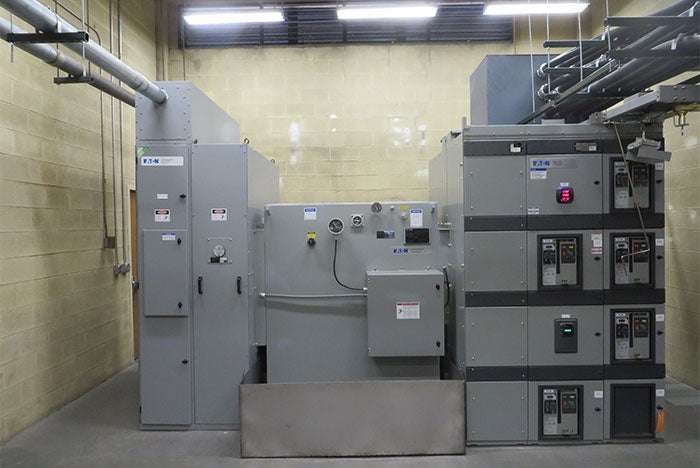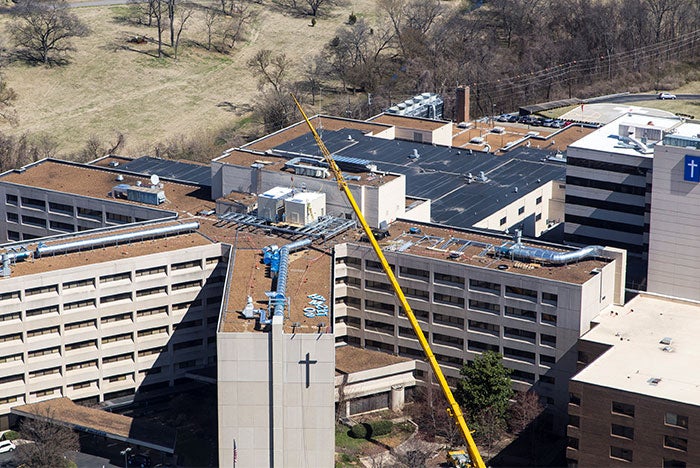Ascension hits Better Buildings Challenge goal three years early

Dell Children's Medical enter of Central Texas contributes to Ascension's energy-efficiency goals through its rooftop solar panel installation.
With three years to spare, Ascension not only hit the Better Buildings Challenge goal to reduce energy waste by 20 percent by 2020, but also surpassed it. From July 2008 to December 2016, Ascension, the largest nonprofit health system in the U.S. and the largest Catholic health system in the world, was able to reduce energy usage by 21.4 percent. Its energy-reducing efforts saved $53.3 million in costs and reduced carbon dioxide emissions by 1,114,600 tons across its 141 acute care hospitals. Lois Sechrist, environmental stewardship analyst at Ascension, says those big numbers all started with one small goal.
“We started tracking energy use in our hospitals in 2008 and set an initial goal to reduce our energy use 5 percent across our hospitals, and we met that fairly quickly,” Sechrist says. “We met that within a couple of years by picking off the low-hanging fruits. And so, we had a number of our hospitals come to us and say, ‘We’ve been doing sustainability projects and environmental stewardship projects for years. Who’s tracking that from a central standpoint?’”

The electrical substation at St. Mary’s of Michigan Medical Center, Saginaw, Mich., contributes to Ascension's 21 percent energy use reduction.
At the time, Ascension had 68 acute care hospitals in its family, fewer than half of its number today. With such a large and continually growing system, it was clear that ito push farther in its sustainability goals, Ascension needed a formal program. In July 2011, the health system joined the Department of Energy’s Better Buildings Challenge, one of two health systems that initially did so. All of its hospitals enrolled in the Energy Star Portfolio Manager to track electrical and gas use, eventually adding tracking for water and sewer. And, most importantly, it developed a systemwide Environmental Stewardship Program to uphold the health system’s mission.
Ascension’s Environmental Stewardship Program tracks sustainability efforts across nine areas:
- Leadership and infrastructure
- Education and communication
- Energy efficiency
- Water conservation
- Waste management and reduction
- Food systems
- Chemical management
- Sustainable site and transportation
- Environmentally preferred purchasing
Although vision across these nine categories is cast at the system level, the actual implementation tends to happen on a region-by-region and hospital-by-hospital basis. Tracy Williams, chief operating officer of acute care within Ascension’s St. Vincent’s HealthCare, oversees the operations of three Florida hospitals: St. Vincent’s Medical Center Riverside, St. Vincent’s Medical Center Southside and St. Vincent’s Medical Center Clay County.
Some of St Vincent’s sustainability programs stretch across all three hospitals, such as eliminating the use of plastic foam and purchasing paper alternatives. The hospitals also partner with local farmers for food service operations by purchasing what it calls “perfectly, imperfect produce,” which is produce that has its nutritional value and quality intact but may have an off-shape that grocery store shoppers aren’t likely to purchase, but can be chopped for sautéed veggies and soups. It also brings farmers on-site for its community and business associates to purchase food.
Other programs, however, may apply to only one or two hospitals, and each location is given flexibility to determine which issues to tackle and how.

The HVAC system at Saint Thomas West Hospital, Nashville, Tenn., was upgraded with a 100 percent outdoor air system with heat recovery to improve indoor air quality and save energy.
“Here at Jacksonville, we have three hospitals in our acute care division, and each one of these hospitals is very different,” Williams says. “So, our Riverside hospital just celebrated its 100th year. We still have parts of the building that were built in 1928. And then, our newest campus in Clay County was built in 2013. So, as you can imagine, when you’re looking at energy conservation and different environmental factors, our hospitals run the gamut in terms of what we can do.”
Williams partners closely with Medxcel Facilities Management in Indianapolis to help make those determinations. The Clay County facility was built with advanced technology to manage energy and water usage, whether on-site or remotely. At its Riverside hospital, however, the team is looking at other energy-saving features such as retrofitting windows and other building components.
Michael Argir, CEO and president of Medxcel Facilities Management, says those decisions are not made within a vacuum, but with the insight of trusted sources. Eight of Ascension’s nine goals come from Practice Greenhealth, and resources from such organizations as the American Society for Healthcare Engineering also have offered guidance over the years.
“Sustainability offers a strategic framework that unifies everyone around the world to optimize environmental, economic and social benefits,” Argir says. “Through the American Society for Healthcare Engineering's Sustainably Roadmap for Hospitals, Medxcel FM has established four key goals that are incorporated into our daily work. They include reducing energy use, waste and costs; getting ahead of the regulatory curve; enhancing the environment for patient care; and improving our organization’s standing in the community.”
Now that Ascension has hit its Better Buildings Challenge goal, Sechrist says Ascension is eagerly looking to the next five years, and is working to better align each hospital with the systemwide mission. Each hospital is in the process of formalizing its green team structure by aligning it with environment of care committees. Sechrist says it’s an alignment already happening at some of its hospitals with great success. For 2018, each team is tasked with choosing two of the nine focus areas within the Environmental Stewardship Program and creating a reporting template to track successes and accomplishments.
“We are able to demonstrate the economic, environmental and social benefits of caring for the earth while we carry out our mission of delivering compassionate, personalized care,” Sechrist says. “Our decisions today will be far-reaching, as we work to provide the best care possible to those we serve while providing the ability for future generations to meet their own needs.”




